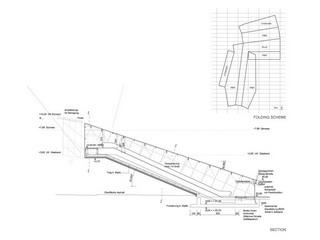Suspended Glass Footbridge over the Gürtel Boulevard
This project may be the worlds first fully-glazed suspended bridge. The bridge takes the pedestrians, coming from the historical Otto Wagner metro station up along an escalator to a horizontal platform 8,5 metres over the most frequented traffic artery in Vienna, the Gürtel Boulevard. From there one can reach the entertainment and shopping centre Lugner City. Through a series of interconnected buildings this multifunctional complex forms a strong pedestrian axis, which reaches up to the nearby City Event Hall and represents a much frequented urban connection. Being the first entrance element of this axis the bridge plays the role of a landmark for this big complex. We decided to make it dynamic, light and attractive, like a funny flying object, which hovers over the pulsing city. It hangs on the building with two cables. The escalator is not parallel to the street and in this way dynamically shows the direction of the pedestrian flow to the horizontal trapezium-like platform, where there is a café with a panoramaic view along the boulevard up to the hills surrounding Vienna. Many Viennese and as well as tourists come to sit in the café-terrace to admire the view.
A peculiarity of the bridge is its refined relation between construction, solid geometry and skin. The regular subdivided surface is folded over the non-parallel sides of the solid so that the individual impression of the space has a changed perspective. The contrapuntal lodgement of the layers of the geometrical systems has a special attraction, which the visitor feels even though one does not consciously perceive it.
The main construction is with larg-dimension steel girders to avoid problems of vibrations. The sub-construction that supports the glazing consists of massive steel beams with a rectangular cross section. For the glass envelope the simple principle of folding a regularly grated surface is used. The surface is divided in right-angled elements and then, like Japanese origami, it is folded so that all sides of the bridge are coated. The lines of the raster represent the supporting construction for the glazing. Since most of the sides are not parallel, the partitioning of all fronts gets a different direction. Thus an unforeseeably alive geometry of the surfaces of the entire envelope is achieved and since the optical impression of stability is decreased, and bridge obtains scale, ease and aliveness. Thus the object developed more than planned and represents our ideas about Design as Process.
The glass panels are connected to the supporting steel grid with a hidden mechanical fixing, integrated in the spacer. This innovative fixing system allows for a typical appearance of a complete glass facade. Another innovation for Austria is the frameless use of large formats of insulating laminated glass (2 x 5 mt-triple-glazing).The blue illumination at night creates an attraction in what was previously a monotonous part of the boulevard. Now the glass wrap of the bridge is interacting with the city, mirroring the lights of the passing cars and shining with its own lights over the urban environment.








